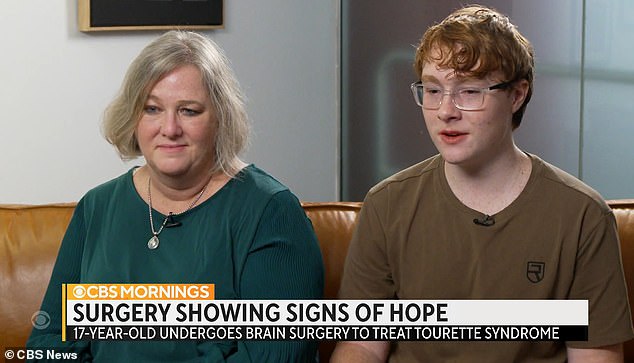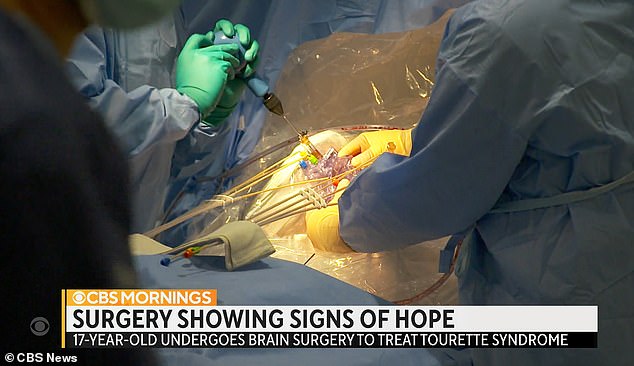Teenager with Tourette’s has an experimental chip implanted under his skin that eliminates tics
>
A 17-year-old Pennsylvania boy with Tourette’s has had his tics drastically reduced through experimental brain surgery.
Callum deQuevedo was plagued by severe tics for three years, including yelling, swearing and head banging.
The successful surgery involved inserting a device called a neurostimulator under Callum’s clavicle, which sends a current to his head and produces electrical impulses that block the abnormal nerve signals that cause the tics.
The experimental procedure is typically used to treat Parkinson’s and has already reversed symptoms of the brain disorder in UK patients.
Doctors drilled two holes into Callum’s skull, guided by an MRI scanner. An electrode is then implanted there, connected to a thin insulated wire that is passed under the skin of the head, neck, and shoulder. A stopwatch-sized chip was then inserted near her clavicle connected to the wire into her brain. This chip sends electrical impulses that block the abnormal nerve signals that cause tics. Callum now adjusts the strength of impulses with an app

Callum’s mother, Dawn deQuevedo, said she had to see about 30 doctors over seven months to get a diagnosis of Tourette syndrome.
Dr. Ted Panov at Mount Sinai West in New York performed the procedure in December.
A few weeks later, leading Tourette expert Dr. Joohi Jimenez-Shahed adjusted the current levels sent to Callum’s brain, something he was eventually able to do himself with a remote control.
Callum’s improvement was gradual but life changing.
He said CBS News after procedure: ‘I just felt like this is the best I’ve felt in a long time.’
‘I feel more relaxed now. It’s nice not to have to constantly move around to distract myself or stop the tics. I can sit at home and watch TV without worrying about yelling, hitting myself, punching myself, or anything like that.
Experimental surgery is typically used to treat Parkinson’s, a brain disorder characterized by involuntary or uncontrollable movements, such as tremors, stiffness, and difficulty with balance and coordination.
Callum’s tics resembled those caused by Parkinson’s. They included yelling, cursing and head banging, head shaking, face crunching and growling.
She would also occasionally wake up in the middle of the night screaming, while other times she felt like she was choking and couldn’t breathe.
Callum’s condition took a particularly bad turn for the worse when he was 14 years old.
His mother, Dawn deQuevedo, said: “So the next day, she sent him to school and the nurse calls and says, ‘Listen, he’s really struggling to breathe.'” So every day that week the nurse called and said, “Something’s not right.”
At that time, no one knew what a tic was. Callum’s parents took her son to an ear, nose and throat clinic, where a diagnosis of vocal cord dysfunction was suggested.
But a speech therapist admitted that Callum’s condition was beyond his experience, so he was sent to the Children’s Hospital of Philadelphia.
It took about 30 doctors to see for seven months to get a diagnosis of Tourette syndrome.
Even after the diagnosis, Callum struggled with his mental health to the point where he attempted suicide.
The treatment is called deep brain stimulation and it works like a pacemaker.
Doctors drilled two holes into Callum’s skull, guided by an MRI scanner to determine where in his brain would be most receptive to treatment.
An electrode is then implanted there, connected to a thin insulated wire that is passed under the skin of the head, neck, and shoulder.

Callum’s severe tics, including yelling, swearing, and head banging, plagued him for three years.

The doctors drilled two holes in Callum’s skull to insert a small conductor into his brain. They used MRI to measure the exact position that would be most effective in reducing her tics.
The wires are connected to a stopwatch-sized lead that is surgically implanted near the clavicle.
A few days after surgery, Callum saw the doctors again, where Dr. Jimenez-Shahed remotely activated the chip to send electrical impulses along the wires to the brain and adjusted the levels to the optimal amount.
The electrical impulses block the abnormal nerve signals that cause Callum’s tics.
Now he can adjust the strength of the impulses himself using an app, and he said his tics have been reduced by 70 percent since the device was implanted.
Dr. Panov said that more improvements will follow in the coming months.
He said: “The brain is smarter than anything we can imagine, and the brain can get this help from this device and start learning along with the device.”
Tourette syndrome is thought to affect more than half a million Americans and 300,000 Britons, the majority of whom are children.
The exact cause of the condition is unknown and it is believed to be caused by a combination of genetic and environmental factors.
The disorder usually begins during childhood, between the ages of two and 14. Half of those who suffer from it say that their symptoms improve with age, while in others it disappears completely.
In rare cases, it can occur later in life due to a “reactivation” of childhood tics or psychiatric or genetic diseases, as well as damaged areas of brain tissue.
There is currently no cure for the syndrome, but treatment, such as therapy and medication, can help control symptoms.
